9: Ol’ Rip
The Texas Horned Toad
Born: c.1897 or Earlier, Most-Likely Texas, United States of America
Died: 19 January 1929, Eastland, Texas, United States of America
In 1897, the city of Eastland in Texas was building a courthouse. A local resident had heard that horned toads, a specific kind of lizard native to the American Southwest, had the ability to hibernate for decades—or even as much as one hundred years--at a time.
Deciding to test that theory, the man (who happened to also be the county clerk) put his son’s pet horned toad in one of the courthouse’s cornerstones in July of 1897. The toad, at the time, was named Blinky. Thirty-one years later, the courthouse was demolished in order to build a newer version. Once the cornerstone was revealed, the residents looked at the horned toad and, voila! He was magically still alive.
(Even more magical—most Texas Horned Toads only live to be five years old in the wild).
Supposedly the story of Ol’ Rip, as he became known, was spread so far and wide that a crowd of three thousand people had gathered to see if the lizard was in fact still alive. They were not disappointed.
Ol’ Rip was given his name after Rip Van Winkle. The people of Eastland were so excited to see Ol’ Rip still among the living that they took him on a tour of the United States. He eventually made his way to Washington DC, where he met President Calvin Coolidge.
Sadly, Ol’ Rip didn’t live long after his re-discovery. A necropsy was performed after his death, and fluid was (supposedly) discovered in his lungs, leading the official cause of death to be listed as pneumonia (and before you ask, I did look it up and yes, lizards are capable of contracting pneumonia!). After the necropsy was completed, Ol’ Rip was embalmed and placed in a glass case display, where he remains to this day in the lobby of the Eastland, Texas courthouse.
In 1973, someone kidnapped poor Ol’ Rip’s final resting place and left a ransom note behind. According to the note, Ol’ Rip’s story was a hoax from the beginning, and the kidnapper wanted the other co-conspirators to come forward and pay a ransom to him. No ransom was ever paid, and no conspirators ever came forward. Eventually, Ol’ Rip and his coffin-display-case were recovered at the Eastland fairgrounds. He was returned to the courthouse, but now some wonder if it really is Ol’ Rip in the case or if the lizard had been swapped with a different corpse.
Today, a statue of Ol’ Rip is located on the Texas Christian University campus.
Texas Horned Toads are native to Texas and Oklahoma, but sadly the toads are now beginning to disappear. In Texas they are classified as threatened, and in Oklahoma they are listed as needing to be of the “greatest conservation” level. The reason for the Texas Horned Toad’s decline can be traced to two things: human invasion of their native territory, and fire ants that are native to South America. The fire ants have driven out the majority of the ants native to Texas, which made up the bulk of the Texas Horned Toad’s diet, and the ants can also invade the nests of the Texas Horned Toad’s and eat their young.
The Texas Horned Toads are also eaten by a huge variety of other native wildlife, everything from coyotes to other rodents, bobcats, roadrunners, snakes, the list goes on—and sadly the Texas Horned Toads move rather slowly and are not good at escaping their natural predators. Their best defense is looking tough while also blending in with their coloring—and they can also shoot blood from their eyes which is pretty cool! But all of this isn’t enough to save the Texas Horned Toads from slowly disappearing from the natural landscape.
The Horned Lizard Conservation Society was founded in 1991 to try to save the critters from complete extinction. In 2001, the Fort Worth Zoo became the first in the world to successfully breed Texas Horned Toads in captivity. This zoo, and other institutions, have begun a mission to breed the toads in captivity before releasing them back into the wild.
Badges Earned:
Find a Grave Marked
Located In My Personal Library:
The Encyclopedia of the Weird and Wonderful by Milo Rossi
Sources:
https://www.eastlandvisitor.com/area/ol-rip.html
https://familyweekend.tcu.edu/history-traditions-tour/ol-rip/
https://www.texasmonthly.com/video/legend-old-rip-horned-toad-eastland/
https://enewspaper.latimes.com/infinity/article_share.aspx?guid=39a30c21-8a24-4bdb-9176-bce8efb285a2
https://www.findagrave.com/memorial/269034375/ol'-rip

